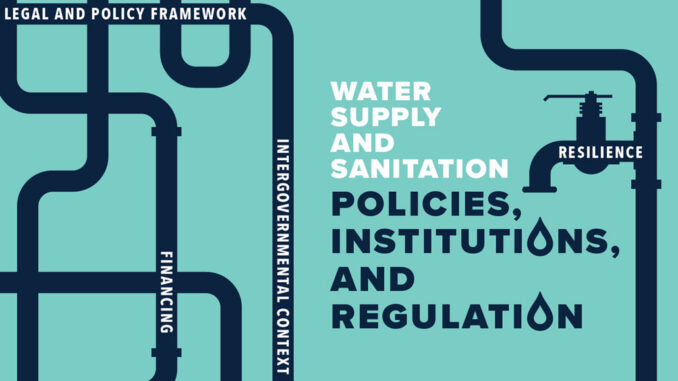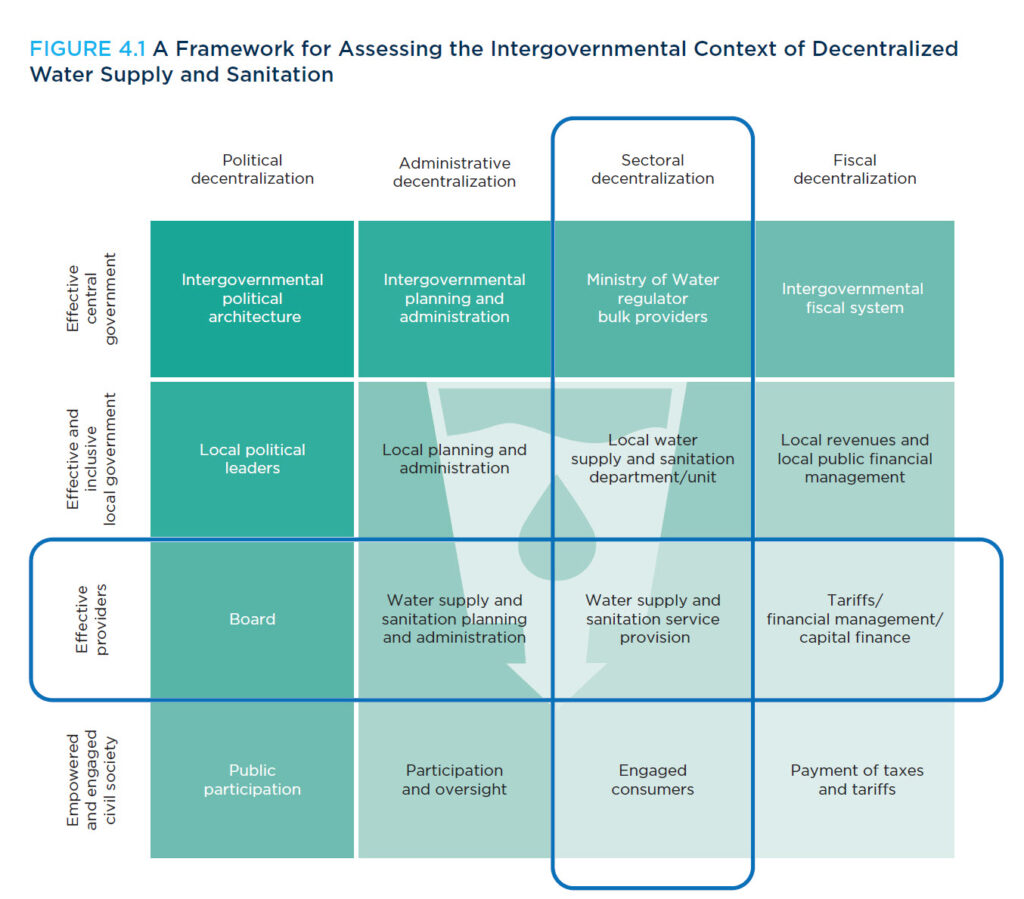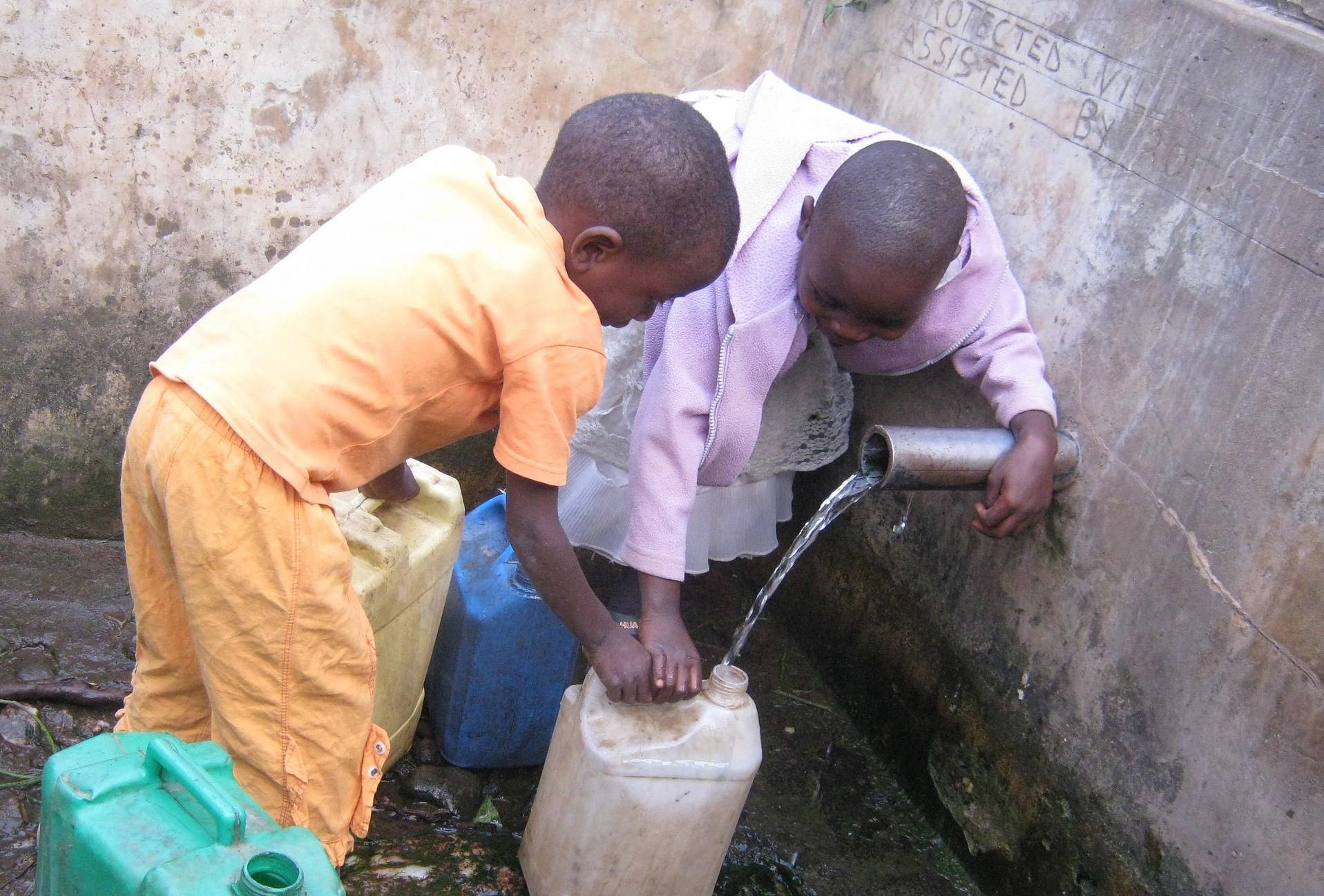
Achieving access to water supply and sanitation (WSS) for all is often not only a question of resource availability and funding, but equally a matter of good governance. In places where providing access to WSS services continues to be a challenge, the “water crisis” is often largely a governance crisis—which typically has a strong intergovernmental dimension.
This is true irrespective of the degree to which WSS services are centralized, as they have a critical vertical or intergovernmental component, regardless of the approach to localization. The more that is learned about how policies, institutions, and regulations work in different countries, the clearer it becomes that the vertical or intergovernmental aspects of WSS services, and the multilevel nature of water governance, is a major dimension of the sector’s policy framework, as well as of its regulatory structure and financing.
The report (Chapter 4: Intergovernmental Context) emphasizes three main lessons with respect to water and sanitation in an intergovernmental context:
- Multilevel aspects of water sector governance are an important part of the enabling environment for effective WSS service delivery.
- Problems related to weak local capacity for water and sanitation service provision cannot be resolved by technical solutions alone.
- Recognizing the unique features of WSS service—and aligning them with the prevailing intergovernmental framework—is often the key to successful service delivery outcomes.
Gustavo Saltiel, the World Bank Global Lead for Water Supply and Sanitation (WSS), provides an overview of the main conclusions of Water Supply and Sanitation Policies, Institutions, and Regulation: Adapting to a Changing World.
The World Bank’s Water Supply and Sanitation Policies, Institutions, and Regulation (PIR) initiative
The World Bank launched the Water Supply and Sanitation Policies, Institutions, and Regulation (PIR) initiative in 2016 as a new approach to water sector reform. While previous global initiatives offered a range of promising technical solutions to expand water and sanitation infrastructure, these efforts often did not have a sufficient understanding of the policies, institutions, and regulatory framework necessary to improve service delivery and to operate and maintain water and sanitation infrastructure in a sustainable manner.
The initial phase of the PIR initiative (2016–19) sought to build strong empirical and literary foundations through the seminal report “Aligning Institutions and Incentives” (Mumssen, Saltiel, and Kingdom 2018). Based on an extensive literature review that analyzed trends and theories on public sector reform as well as the insights gained from 10 country case studies, this framework posited that integrated policy, institutional, and regulatory interventions can help align incentives for more sustainable WSS service delivery.
The second phase of the PIR initiative (2019–22) was recently concluded. The resulting synthesis report, Water Supply and Sanitation Policies, Institutions, and Regulation: Adapting to a Changing World, reflects on the body of PIR knowledge and experiences to refine the concept and advocate for greater action by policy makers, development partners, international financial institutions, and civil society. In addition to the three fundamental building blocks of policies, institutions, and regulation, this report proposes an expanded analytical framework that includes some important but hitherto less developed themes: intergovernmental context, financing, and resilience. This expanded analytical conception of PIR encompasses a deeper analysis of financing, intergovernmental issues, and resilience in a constant feedback loop.
Placing water and sanitation in an intergovernmental context
WSS services typically have a critical vertical or intergovernmental component, regardless of how centralized or decentralized the sector is. Figure 4.1 provides a framework for understanding how WSS, PIR, and intergovernmental dynamics all intersect. Until recently, to the extent that the tools available to assess the governance of WSS services focused on subnational aspects of sectoral service delivery at all, many focused exclusively on sector-specific institutions and processes at different government levels. They paid little or no attention to the other elements of the multilevel governance environment.
For their part, when left to their own devices, decentralized governance specialists have tended to focus on the political, administrative, and fiscal aspects of decentralization and intergovernmental relations, without making the connection to sector-specific institutions, frontline service delivery facilities, or service providers. A comprehensive assessment of the intergovernmental context of water supply and sanitation should consider all aspects of decentralization (political, administrative, sectoral, and fiscal) at all institutional levels (central, local, facility and community).
Given common challenges with local WSS delivery at the local level, there is a tendency to focus on the local PIR dynamics rather than the overall intergovernmental system. For instance, there is a common expectation in the water sector that local government leaders should ensure that local WSS providers collect adequate tariffs; and that they monitor the performance of these providers and hold their managers accountable. In reality, local government officials often face conflicting political or institutional incentives: they may face political party pressure from higher levels to resist imposing higher tariffs and may lack political or institutional incentives to strengthen local water departments or to monitor the performance of a WSS provider. This is especially true if local governments have few—if any—levers to ensure more inclusive or effective performance of WSS providers. On the other hand, sector line ministries at the central government level—and their counterparts in the development community—tend to pursue technical interventions or programs that limit the role of local governments in WSS provision or that bypass local governments, rather than pursuing reform of intergovernmental systems that would systematically strengthen local governments’ role in WSS provision.
Upon closer inspection, local weaknesses are often found to be proximate causes of poor WSS service delivery rather than the root causes of the public sector’s failure to ensure adequate access to water and sanitation. It is therefore important to interrogate why local politicians lack the incentives to promote better local services; why both sector ministries as well as elected local leaders often fail to invest in administrative capacity within the sector; and why intergovernmental fiscal systems often fail to shift resources where they are needed most. This leads back to the point raised above, that the intergovernmental system itself is often designed in a manner that does not lead to optimal service delivery outcomes. Unless the differences in perspectives and incentives are understood and resolved through effective dialogue and coordination, central government efforts to bypass or minimize the role of devolved local governments tend to create contentious relationships between WSS stakeholders at different government levels.
Read more and access the report on the World Bank’s website: Water Supply and Sanitation Policies, Institutions, and Regulation: Adapting to a Changing World






